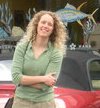
| Volume 35 #6 | May/June 2019 | |
Dear Fellow Dancers, I have not been doing much dancing, in part because of Parkinson’s but mainly
because of the final details of publishing a book, “The Voice of This Stone—Learning from Volcanic
Disasters Around the World.” Each chapter is my experiences and scientific conclusions at each of many
volcanoes around the Pacific Rim of Fire, plus Vesuvius and Campi Flegrei. The book has received great
reviews and has a wonderful website, http://www.volcanicdisasters.com
I think, if you like volcanoes, you will like the book.
All of us are role models for newer dancers – either inadvertently or purposefully. Through observation, inexperienced dancers absorb our good and our not so good behaviors – including our dancing technique, styling and our social conduct. I know this first hand! When I was first learning to dance, I was bending my big toe under and dragging it behind me while I was bringing my trailing foot through as part of the strathspey travelling step. I did this because that is how I observed the teacher dancing the step. I did what she (inadvertently) demonstrated, not what she said when she made her teaching points.
The experienced dancers in the Portland and Vancouver area dance communities provide excellent role models overall. However, there are instances where we should ask ourselves if we are (inadvertently) presenting less desirable role models.
First, the good! In the below situations I think our experienced dancers set splendid examples:
- Newer dancers attending classes are actively welcomed.
- Their dancing efforts are encouraged.
- Information is shared, questions answered, and efforts are made to try to ease their entry into our dance
community.
- Newer dancers are quickly asked to be dance partners.
- Experienced dancers patiently attend beginner level classes to lend support in numbers and spirit.
- Newer dancers receive invitations to non-dancing social events.
Second, here are examples of when we generally model beneficial behaviors but perhaps we could do so more
consistently:
- Partnering with a variety of dancers. Why not make a point of asking someone to dance who, despite
your good intentions, somehow rarely is your partner?
- Good-hearted and light-hearted acceptance of mistakes made by other dancers and by ourselves.
Newer dancers need assurance that mistakes (by everyone!) are normal, common, and expected.
- Not over helping a newer dancer during a dance. It is confusing if multiple dancers in a set provide
guidance to a newer dancer simultaneously; also, letting them learn from their own mistakes is sometime
the most helpful.
- Proactive sharing of information about shoes, dress norms, and online resources.
Lastly, we should consider if we are being good role models in the following situations:
- Do we talk in class such that others may not be able to hear the instruction? Echoing halls and hearing
loss can make even quiet talking problematic.
- Do we make unkind remarks about other dancers or teachers? These are our friends!
- Do we look at the floor when we could be giving a friendly face to another dancers, for example, when
we cross or turn or reel or step up?
- Do we stomp our feet or click our heels during the change in direction in quick time circles? Yes, this can
be fun but it’s not the SCD norm so perhaps it is not the best dancing style to be modelling for beginners.
- Do we dance with one (uninjured) arm behind our back? This is not SCD style and it might seem a bit unsocial
to other dancers.
- Do we sometimes focus on our own fun, inadvertently to the detriment of others in the set?
For example:
- Do we lead down the middle so far that it is impossible to return on time for the next figure, thereby impeding
other dancers from starting the next phrase on time?
- Do we dance quick time circles too fast so the change in direction is uncontrolled, not on the musical phrase,
and other dancers may be pulled off their feet?
- Do we add extra twiddles and pivots that may confuse a newer dancer or impede another dancer from being where
they need to be? Taking a few liberties with a dance can be good fun, but we should consider who is in the set and
ask ourselves if it a considerate thing to do during the active teaching of a figure or portion of a dance.
- Do we have our shoes on and are ready by the start time of class (traffic and personal woes being worthy
exceptions, of course)?
As we know, Scottish Country dancing is tremendous fun, and we don’t want to get overly fussy about styling and technique. That said, providing strong role models helps to develop our newer dancers and supports the continuing uniqueness of the Scottish Country dance style. Personally, I extend a big thanks to the experienced dancers in our community for their continuing efforts to grow our newer dancers; well integrated newer dancers will position our groups to be dancing strong in the years ahead.
I've certainly been guilty of some of these. It's worth it to be reminded of the fundamentals. ~ The Editor
From the January/February 2012 edition of The Scottish Country Dancer. ~ The Editor"
 |
If someone had told me a little over a year ago I would be involved in Scottish Country dancing my response would have been incredulous laughter. My dancing experiences consisted of a best forgotten year-long stint as a seven-year old ballerina and an occasional swing dance routine with college friends. So when my Mom, who lives 1,700 miles away but gets the local Lake Oswego paper, told me about an ad she had seen for a Scottish Country dance class practically in my backyard. My response was the typical “whatever” eye roll. I made a concerted effort to “forget” about the class. But as summer drew to a close and some of my other outdoor activities were winding up, I decided to give it a try. After all, it was free the first time and if, and I was sure when, I found Scottish dancing wasn’t my thing I wasn’t out any money and I could say I had tried it.
Except it didn’t quite work out that way. I don’t remember a lot about that first class, except no one else was in running shoes. But that didn’t seem to matter. Everyone was very friendly and welcoming and eager to help those of us who were new. We did a few simple dances, and it dawned on me that this was a lot of fun, not to mention great exercise that didn’t involve being out in the rain. Plus, there was this terrific music to listen to and almost be part of. The only downside to all this fun was having to admit to my Mom that she was right, something she won’t let me forget. But now the ghillie is on the other foot and she is the one rolling her eyes when I go dancing multiple times a week, plan my vacation return flight around the monthly dance in Lake Oswego, and walk to workshops wearing running shoes and a skirt.
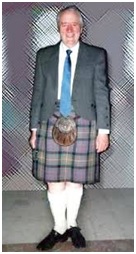 |
In the last newsletter issue, I wrote about little notes John included in some of his dance booklets. In this issue, I’m writing a bit about the man himself.
John was born on July 14, 1923, the very year of the RSCDS’s founding. He was not a native Scotsman, being born in Melton Mowbray, Leicestershire, England. He found Scottish Country dancing (“SCD”) through a ramblers group and joined the Carlisle and Border Branch and attained his dance teaching certificate. While dancing there, Hugh Foss, the cryptographer and dance devisor, encouraged John’s efforts at dance devising.
Professionally, John’s career began in biochemistry and led to computer programming. In the 1960’s he accepted a biochemistry appointment at the University of Aberdeen and his residence in Scotland began.
John’s head for patterns and interest in music led to his copious output over the years of new dances and the creation of a number of new dance formations. Many of his newly created figures caught the interest of other devisors and have subsequently become standards of SCD, including: corner pass and turn, the rondel, set and rotate, petronella in tandem, espagnole, and half turn and twirl. The RSCDS included 13 of his dances in its publications and John himself published at least 47 books; his output exceeds 800 dances - what a creative and inspired mind! The continued popularity of some of his dances, including The Bees of Maggieknockater, The Blooms of Bon Accord, Bratach Bana, The Byron Strathspey, The Peat Fire Flame, and The Silver Tassie, is a testament to his abilities. His intriguing dances led to him being requested to teach all over the globe. These jaunts inspired yet more dances and books.
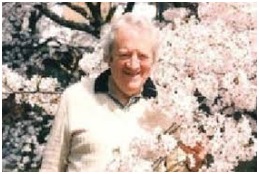 |
John has a reputation for devising complex dances although he wrote many that were not especially difficult. He is also known for being particular and descriptive about how his dances are to be executed. I like to think that he wasn’t being fussy but was using his teaching skills to help the dancers and their teachers. Indeed, sometimes he included the suggestion in his books that a dance only be danced a limited number of times through given its energetic nature.
Upon his death, the Teachers’ Association (Canada) undertook a project to create an index of all of John’s dances. I have excerpted below, from the foreword to the index, remarks written by John himself many years before his death.
“How I Started Devising Scottish Country Dances:
It all began with Flora (No, not Marge!) Flora was a member of our Dancing Class who had elastic legs which
stretched remarkably when pulled ever so gently. Flora was not actually her name - just another leg-pull - and its
use occasioned loud shouts of "You know that is not my name!". Ian, who had christened her "Flora", suspected
that she secretly enjoyed the attention and quoted Queen Gertrude - "The lady doth protest too much, methinks."
"But to our tale:-" it was decided that we should make up a dance for Flora - just another leg-pull. After several
attempts by various people, my reel was chosen; it was taught, without a name, to the class by Liz our teacher,
who then, at the end, announced that we had just danced "Flora's Rant". The results can be imagined!
That dance has faded into history - I no longer even remember how it went - but the seed had been sown and
started to grow. Dances began to appear. For some reason, which I cannot myself explain, I seem to have the
ability to imagine new movements in dances. This may be related to a facility for geometry which I had at school
often getting 100% marks in exams.
The first dance of any lasting value I devised was "A Trip to Tobermory" - a 24-bar strathspey - which I had printed
on a leaflet. Liz took copies to St. Andrews (I had not advanced that far in those days) and gave one to Miss Milligan.
A year or so later, this dance appeared on Younger Hall programmes at the Summer School and I felt that I had
arrived!
In the meantime I had become a member of the Carlisle and Border Branch and, when I had produced a set of
reasonably interesting dances, friends in the Branch organised a session to try them out. They were so enthusiastic
that they encouraged me to produce a booklet of the best of the dances and the "Bon Accord Book" was the result.
The first copies were duplicated by stencil (not printed) and I painted a design of a white rose and heather on pale
blue card for the first hundred covers.
Sometimes ideas came to me with remarkable speed - for example:- "The Bonnie Lass of Bon Accord" was
devised in about ten minutes while listening to a Jimmy Blair recording of the music. (The recording had no
initial chord - hence the 8-bar introduction to the dance). The dance "Bratach Bana" was inspired by listening
to the tune on the radio while I was camping on the shores of Loch Sunart near Strontian - I walked it through
alone on the smooth sand. Occasionally I have woken up in the middle of the night with a complete dance in
my head - this has happened spontaneously without my intending to make up a dance before going to sleep.
Very soon after I started devising dances, I met Hugh Foss who gave me tremendous encouragement. He
supplied me with blank sheets and Lettraset stencils for setting out the music for the Bon Accord Book. This
was a slow procedure - I think it took about twelve hours to prepare each tune.
The dance "Bon Accord" was devised in imitation of a Foss "fugue". It needed special music because it began
with two twelve-bar phrases. Miss Winnie Carnie of Glasgow was kind enough to compose two tunes for the
dance and the second had a quotation from "The Bonnie Lass of Bon Accord" in it. Miss Allie Anderson took
a liking to the dance and it was included in the programme for "An Edinburgh Fancy" in 1966 ("A Trip to
obermory" was also in the same programme.) Since then, the programmes for "An Edinburgh Fancy" have almost
all contained at least one of my dances, which I take as a great compliment.
I moved to Aberdeen in 1965 and the "Drewry" collection has grown and grown until it now numbers over four
hundred dances. Many of them have been devised to satisfy requests and others for me to take with me when I
have been invited to teach in far away places. (I do not always feel able to respond to some requests, like the one
from a lassie who wanted a dance to show her boy-friend how much she loved him.) From the humble beginnings
of "Flora's Rant" in Cumberland, the dances have spread over the whole of the Scottish Country Dancing world
and have resulted in my visiting many interesting places and forming many good and lasting friendships.”
In addition to dancing, John was an active hillwalker and camper and enjoyed gardening, cooking, and photography. He passed away at age 90 in Aberdeen, on June 18, 2014 but he certainly lives on through his dances and the joy they bring to dancers.
From the July/August 2012 edition of The Scottish Country Dancer. ~ The Editor
I'll exercise a little prerogative which I hope you'll all find in your hearts to forgive. For those who know, my mother Mary MacKenzie passed away in her home May 30th of this year, as far as those of us who remain can tell, exactly as she wanted it. However, this is not what I want all y'all to think of. She also came with us from time to time and observed our dancing.
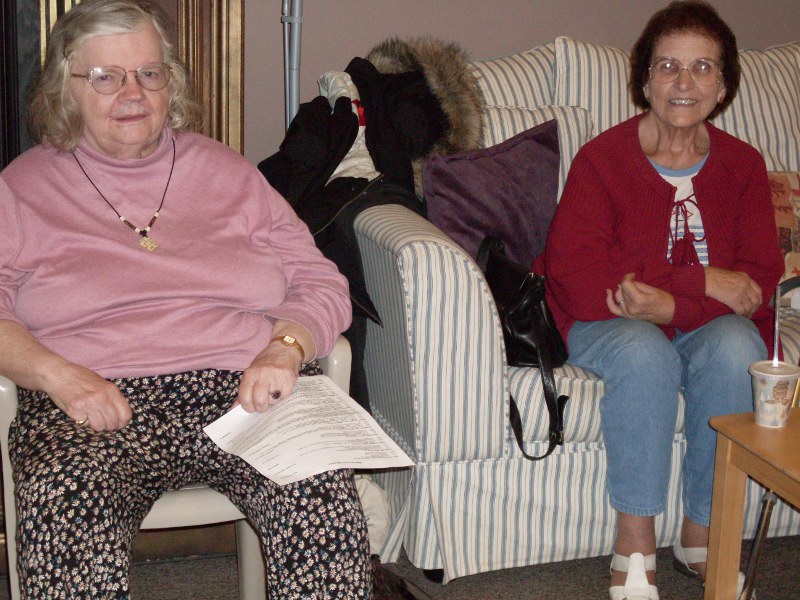 |
This photo was taken at the "222" themed Vancouver spring dance in 2008. One of the things that Mom observed was, "The dancing looks complicated."
In her younger years, she had tried square dancing and, even later in life before her legs wouldn't support such endeavors, her neighbor across the street, Agnes, persuaded her to go to a beginning square dance class at her own square dance club. She found it a little too intense so soon after Dad's passing but it was interesting to me that she tried.
The moral of this story, at least as I declare it, is that we should make contact with observers and, if possible, encourage them to participate with us in the future. Show them your enjoyment of the dance and infect them with the disease!
From a BBC article entitled, "How hydrogen is transforming these tiny Scottish islands" written March 28, 2019.
I’ve seen thousands of petrol pumps in my life, but this is my first encounter with a hydrogen refuelling station. It sits by the road in the Orkney Islands, an archipelago off the north-east coast of Scotland where residents have big dreams: they want to have their cars, ferries and boilers all running on hydrogen.
As we approach the station, its normality is striking. There are no attendants in full-body hazmat suits, no sci-fi loud bangs, no bright neon signs. Just your average dispenser waiting to be used.
But Adele Lidderdale, a hydrogen project officer at the Orkney Islands Council, is a little nervous: one of her van’s sensors has been malfunctioning lately, she says, and might not accept fuel from the nozzle. Now, she plugs the nozzle into her van and steps back to the screen at the other end of the black hose. She looks relieved as the charging process starts with a hydraulic mumble from within the dispenser.
Three minutes later, the 1.4kg tank full, we drive off – all without using one single drop of petrol.
Orkney has five vans that run on hydrogen, a fuel which emits no greenhouse gases or pollution. Since Orkney started planning its hydrogen-based economy in 2016, the process hasn’t always been this smooth. When five vans, including this one, arrived in 2017, the islands didn’t have hydrogen for them, as production was still not underway. After managing to charge the tanks, the planners encountered another potential issue: who can fix a broken hydrogen vehicle in a community of 21,000 people? In response to the challenges, the Orcadians flew in an expert to train a local mechanic, created fresh educational programmes for ferry operators and drafted regulations to update maritime law to allow hydrogen use in vessels. And they aren’t stopping there. If everything goes according to plan, by 2021 the islands will have the world’s first sea-going car-and-passenger ferry fuelled only by hydrogen.
The archipelago might seem an unlikely place for such cutting-edge aspirations. But if it can succeed, it may inspire other communities to move away from fossil fuels too. As Lidderdale says: “If we can dream that you can run a ship on hydrogen, there’s no reason others won’t follow.”
Unlike petrol or marine diesel, burning hydrogen does not, in itself, produce any harmful by-products. Now, as we drive through Orkney’s capital of Kirkwall, hydrogen combines with oxygen inside the van to produce an electrical reaction that powers the engine. The only tailgate emission is pure water. In other words, there’s no air pollution and no greenhouse gas emissions (such as carbon dioxide) that contribute to global warming. Beyond cars, hydrogen could be used to heat buildings, power electrical facilities, propel trains, ferries and cargo ships and for industrial processes.
Another benefit of hydrogen? If you have too much, you can store and transport it at a large scale with relative ease. As one Bloomberg New Energy Finance consultant wrote in a column published last year, hydrogen “is one of the most promising ways of dealing with longer-term storage, beyond the minutes, hours or days that could be met by batteries”
But producing hydrogen is complicated. Even though it is the most abundant chemical substance in the universe, very little of it is freely available as a gas, instead forming strong bonds with other elements (for instance with oxygen to create water). You need to break up those links to “free” it for use. That process requires a great deal of electricity – electricity which may not come from “clean” sources itself, and that could be used for other purposes, for instance powering electric vehicles to begin with.
A cheaper way to produce hydrogen, meanwhile, involves using methane and carbon capture and storage (CCS). Some experts argue it might make more sense at scale, but might not be as clean. However, research published in February 2019 suggests that hydrogen produced using renewable electricity might be cost competitive and might match CCS within a decade.
But for Orkney, hydrogen via electricity works just fine. The islands already boast one of the highest densities of electric vehicles in the United Kingdom. And most crucially, thanks to sources like tidal and wave energy, Orkney creates more clean electricity that its inhabitants need. Even after exporting to the UK national grid, the islands’ winds, waves and tides generate about 130% of the electricity its population needs – all of it from clean sources.
As electricity is hard to store at a large scale (we still don’t have humongous batteries for whole communities), some wind turbines must switch off on occasions to avoid damaging the power lines to the UK mainland, which can’t be updated cheaply.
Orkney gets its clean energy from sources like tidal and wave energy. This curtailment annoys the Orcadians and it is also expensive for the communities that invest their in clean energy. They would rather keep the turbines moving or, alternatively, find a way to use them. So residents came up with an idea: what if we use surplus clean energy to produce hydrogen?
The hydrogen that Lidderdale pumped into the trunk-sized tank sitting behind our backs comes from a long, thin island called Eday, where about 130 people live. Eday had too much clean energy and no way to use it. The island’s population had invested in a community-owned wind turbine in 2012, hoping to sell electricity back into the UK national grid and profit from the green energy revolution. But later that year, the grid operator announced that too many new turbines had sprung up in northern Scotland and that they couldn’t take all the clean energy produced, says James Stockan, Leader of Orkney Islands Council. The island is also where the European Marine Energy Centre (EMEC), the leading global institution for tidal energy, tries new tidal turbines in the rough Scottish waters.
With two reliable sources of clean energy, the island became an ideal place to start producing hydrogen. In September 2017, after research aided by a £1.4 million grant from the Scottish government, they had their answer. Inside a green trailer-sized container, they ran electricity through water to split the molecules into hydrogen and oxygen in a process called electrolysis. The oxygen was harmlessly released back into the atmosphere; the hydrogen was carefully compressed and stored into cylinders. The cylinders first were used for a humble enough application: they were converted into electricity on a fuel-cell at Kirkwall harbour, with the result of powering lights on some of the harbour’s vessels as well as heating a nearby sailor hall.
It was the proof that if you have too much wind on Friday, you can create hydrogen with it and then use it to switch on your lights, heat a room or power your car on Sunday. After that, new projects started coming in fast. A second electrolysis station was installed on the island of Shapinsay, as well as a boiler for a school and blueprints to create a hybrid ferry. In the meantime, there were several charging stations and five retrofitted vans were running on hydrogen. But there were even bigger goals ahead.
As our ferry left the harbour, the engine growled with diesel and pistons. No-one on board seemed to mind. The dozen or so passengers on the Kirkwall-Shapinsay service remained undisturbed, chatting among themselves or browsing their phones. Our quiet acceptance of that metallic uproar every time an engine kicks off is startling: have we normalised sound pollution? I initially came to Orkney because of this vessel. Companies and governments around the world are contemplating hydrogen as a way to clean up the polluting marine shipping industry, which is responsible for more than 2% of all global emissions of carbon dioxide. When I asked a specialist at the European Climate Foundation about the clean shipping frontier, he told me to visit Orkney.
As an archipelago of scattered isles, the Orkney Islands depend on their ferry system. Medics, goods, teachers and family members hop daily between the harbours, allowing a sense of community to exist. But the ferries also consume about one-third of Orkney’s fossil fuels, hampering the islands’ ambition to become a greener place. “If you’re looking at how to decarbonise the maritime sector, this is one great way to do it,” says John Clipsham, hydrogen manager at EMEC.
The island of Shapinsay, where we are heading, is home to just over 300 inhabitants, dramatic coasts and rolling hills. Next to the pier, Steve Bews, the chairman of the Shapinsay Development Community Trust, waits for me on a white petrol-powered van. We drive through the hilly countryside and up to the wind turbine that sits atop a slope. Built in 2012, the community-owned turbine has created enough income to provide educational grants, an electric taxi for community errands (there are no taxis on the island) and a subsidy for an extra ferry ride to Kirkwall every evening. But it’s also curtailed, limiting its profitability; Bews says that 36% of its potential was going to waste.
When several organisations approached them some years ago looking for their surplus electricity to produce hydrogen in Shapinsay, the trust agreed. “We’ve got loads of electricity, it’s green and it made sense,” says Bews, who’s a builder by trade and volunteers at the community organisation.
The electrolysis station was under construction in December 2018 and should be ready in early 2019. It will be able to produce 500 kg of hydrogen a day, roughly the daily demand of the Kirkwall-Shapinsay service if it becomes operational. The people in Shapinsay get to sell their surplus electricity and they get cheaper heating for their children: a catalytic hydrogen boiler next to the local school waits for fuel to heat its classrooms.
A while later, Bews drops me off again by the pier. Once onboard, the ferry leaves Shapinsay with its metallic song of 20th Century transportation. I wonder if its days are counted. Even if marine diesel days have an expiration date, don’t hold your breath. Orkney’s plan is a prototype. The rest of the world following will take years or decades. Still, first steps are promising. Work on the ferry project is already underway at Port Glasgow, where the partnering shipyard Ferguson Marine is based. Meanwhile, a Californian project called Water-Go-Round promises to have a functioning hydrogen ferry later this year, a joint Norwegian-Swedish programme is exploring how fuel-cell technology can move larger vessels and a Japanese shipping giant announced plans for a 200m-long zero emissions cargo ship by 2050. On the policy level, the International Maritime Organisation (IMO) agreed in April 2018 to reduce the sector’s greenhouse gas emissions. Countries gathered in IMO’s London headquarters promised to reduce their footprint by 50% by 2050, compared to 2008 levels.
It’s a big shift for any community to make. From the house I stayed at in Stromness, Orkney’s second most populous town, I could see Flotta, a small island known for its oil terminal. At one point, it had the second largest oil terminal serving the UK’s North Sea. Compared to the island’s optimism about clean energy, the terminal felt like an ominous presence – both a relic from the past and a reminder of how intertwined fossil fuels are with our current social fabric.
Caron Oag, EMEC’s hydrogen marketing officer, told me her dad worked for the oil terminal for years. It’s a story that’s heard all over the islands. “A lot of people of my generation grew up in households where the oil industry was their income,” said Oag. Like many young Orcadians, she felt her homeland offered few professional pathways and moved abroad to work and study. But that has changed. The clean energy industry is now providing Orkney’s youth with new options beyond farming and fossil fuels. “My job is a good example of how we are creating new opportunities,” says the council’s Lidderdale, who worked for EMEC between 2012 and 2016. Many people in Orkney seem proud of the sophistication of their technologies. But they seem even prouder of the ability to do exactly this – provide quality jobs for their young professionals. The industry’s potential even is drawing in people like EMEC’s Clipsham, who relocated here from Germany.
Maybe Orkney can provide a roadmap for other small communities that are loosely connected to national or regional capitals. Maybe the transition away from fossil fuels opens a window of opportunity for these regions. “There are thousands of islands in the world,” says council leader Stockan. He dreams about a carbon-free world where islands take the lead, instead of being an afterthought for policymakers. “We have got an exportable commodity (with hydrogen) we can share with them, so that islands don’t get something last – but they can get something first.”
From the September/October 2005 edition of The Scottish Country Dancer. ~ The Editor
What would it be like to dance a Scottish dance in a Scottish castle? Imagine dancing "Ye'll Aye be Welcome Back Again", or any of the other dances from the Menzies manuscript (dated 1749), in Castle Menzies, where the manuscript was discovered!
Prompted partly by such romantic curiosity, John and I joined Ken McFarland's Dancing in Scottish Castles tour; and, in the company of about 30 other dancers and two musicians, we danced, walked, and toured our way across the width of Scotland, as well as a good bit of its height.
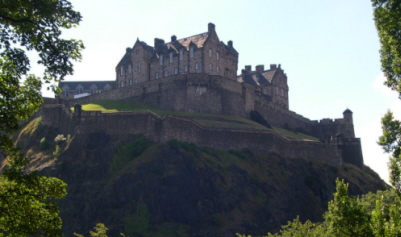 |
We were unprepared for the sights of original Edinburgh surrounding the castle. The sooty black gothic tower built in Sir Walter Scott's memory was hard on our eyes, but "new town" built at the end of the 18th century was charming. Modern shops crowd next to woolen mill outlets and Scottish items galore, including a full range of kilt attire. In August, cashmere scarves are on "SALE" throughout Scotland. Within walking distance of our hotel were several curved streets (called a "crescent") flanked by a row of tall townhouses. It turns out that the headquarters of RSCDS is in one of these crescents and a fun thing to do is to have your picture taken next to the large portrait of Miss Milligan.
Our tour took us south of Edinburgh across the Borders to Holy Isle on the east coast, then up through the Highlands and over to the Isle of Skye, which is part of the Inner Hebrides, and down to Ayrshire, the land of Robert Burns - all on the west coast. We were blessed with good weather and clear views the entire trip.
We learned that the first castles were built in the 12th century to protect against Viking invaders. In the 16th century, better and bigger castles were built on their ruins. Then, many castle-like mansions and large estates were built in the Victorian Medieval style in the early 1800s. We saw and/or danced in all three kinds of castles, as well as hotel ballrooms, to the music of Duncan Smith (piano) and Catherine Fraser (fiddle), the two fine Australian musicians who traveled with us.
One special memory was standing on the Brigadoon (bridge over the River Doon, in Ayr) and listening to fellow traveler Norm McCallum and John Shaw take turns reciting the Robert Burns' poem, Tam O'Shanter. It was on this bridge that the beautiful witch, Nanny (nicknamed Cutty Sark), was left holding the tail of Tam's horse as he sped across the bridge to escape her. (As we all know, a witch cannot cross a running stream.)
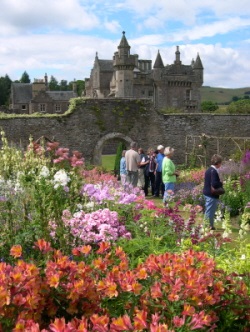 |
The ruins of the abbey, where Tam first spied the witches dancing "hornpipes, jigs, strathspeys, and reels," are just a short walk from the bridge, and in the graveyard there we saw the graves of Robert Burns' mother and father, who both outlived Robert by many years. It seems that all of Scotland loves Burns, and in Ayrshire he is everywhere. I loved the museum next to his birthplace cottage, which has an extensive collection of his original writings, including handwritten letters and tributes to friends written in perfect English as well as works in his native Scots tongue.
In the lowlands we visited the home built by Sir Walter Scott, the great historic fiction novelist, who loved to collect books as well as memorabilia from famous warriors and anything Scottish, including Rob Roy's sword and gun, Napoleon's journal and pen set, and full suits of armor from the 16th century. We all loved his walled flower garden, which was my favorite of all the gardens on the tour.
So, you get the idea that Scotland is a great place to visit, especially in August when the weather is the best, though the prices are the highest then - except for cashmere, of course.
When all the pictures are developed and sorted, we'd love to share.
Calendar of Events | |||||
|
|